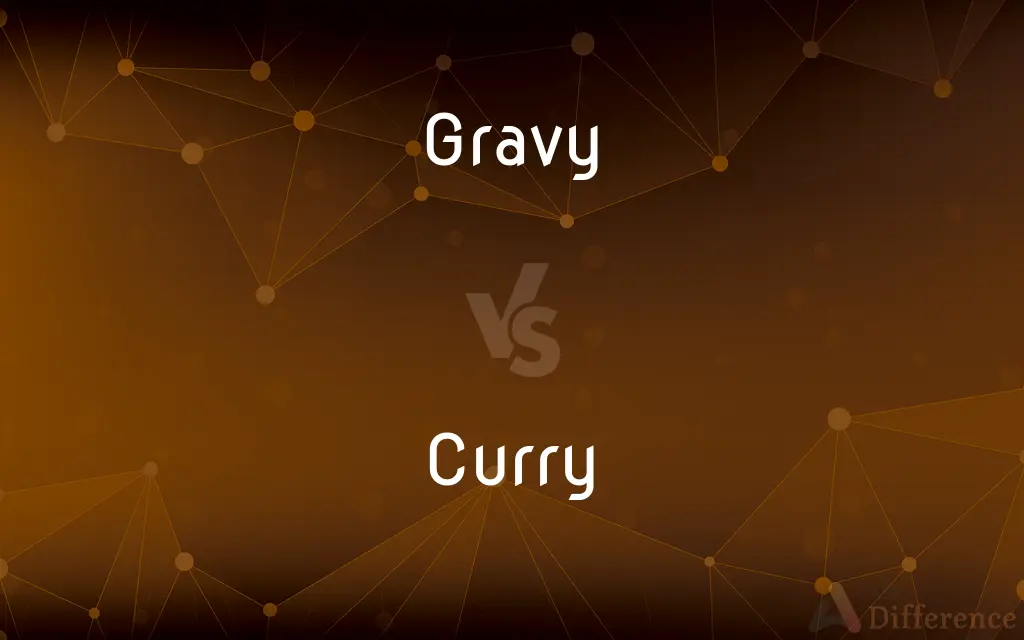Gravy vs. Curry — What's the Difference?
By Maham Liaqat & Fiza Rafique — Updated on March 1, 2024
Gravy is a sauce derived from meat juices, often thickened with flour, while curry is a complex blend of spices and herbs, including turmeric, cumin, and coriander.

Difference Between Gravy and Curry
Table of Contents
ADVERTISEMENT
Key Differences
Gravy is traditionally a Western sauce made by using the juices that run naturally from meat or vegetables during cooking. It's often thickened with wheat flour or cornstarch to create a smooth texture. On the other hand, curry is a staple in various Asian cuisines, characterized by its combination of spices and herbs, which can include turmeric, cumin, ginger, and many others, offering a complex flavor profile.
While gravy tends to accompany roasted meats, potatoes, and rice, aiming to enhance the natural flavors of the dish, curry serves as the main component of a dish, often including meat or vegetables, and is known for its rich, deep flavors and sometimes spicy character.
Gravy's consistency is generally smooth and thick, aiming to complement the main dish without overpowering it. Whereas, curry can range from a thin, soup-like consistency to a thick stew, heavily influencing the dish's overall taste and texture.
Gravy is typically made in the same pan used to cook the meat, incorporating the browned bits and pan drippings for added flavor. Curry, however, requires a separate preparation process where spices are often sautéed in oil to release their flavors before adding the main ingredients.
Gravy is usually seen in traditional Western celebrations like Thanksgiving and Christmas, symbolizing comfort and homeliness. Curry, on the other hand, is celebrated in many parts of the world for its versatility and ability to adapt to local tastes, making it a symbol of cultural diversity.
ADVERTISEMENT
Comparison Chart
Base Ingredients
Meat juices, flour or cornstarch for thickening
A mix of spices and herbs (e.g., turmeric, cumin)
Origin
Western cuisine
Various Asian cuisines
Consistency
Generally smooth and thick
Ranges from thin to thick
Role in Dish
Complementary sauce
Main component or sauce of the dish
Flavor Profile
Enhances natural flavors of meat or vegetables
Complex, can be spicy, rich in flavors
Compare with Definitions
Gravy
A staple in traditional Western holiday meals.
Thanksgiving dinner wouldn't be complete without turkey gravy.
Curry
Often served with rice or bread to absorb the sauce.
She scooped up the curry with warm naan bread.
Gravy
Often served with poultry, beef, or pork to enhance moisture and flavor.
The roast beef was accompanied by a rich, savory gravy.
Curry
A dish prepared with a complex blend of spices and herbs.
We enjoyed a spicy chicken curry for dinner.
Gravy
Can vary in color and thickness depending on the base used.
The onion gravy was a deep brown and perfectly complemented the sausages.
Curry
The spice level can range from mild to very hot.
He ordered the curry extra spicy and regretted it later.
Gravy
A sauce made from cooked meat juices, thickened with flour or cornstarch.
She poured gravy over the mashed potatoes.
Curry
Can be made with a variety of main ingredients, including meat, fish, or vegetables.
The vegetable curry was full of flavor and color.
Gravy
Can be made from vegetable stocks as a vegetarian option.
The vegetarian gravy was a hit at the dinner table.
Curry
Integral to many Asian cuisines, each with its unique variations.
The Thai green curry had a wonderful balance of coconut and spice.
Gravy
Gravy is a sauce, often made from the juices of meats that run naturally during cooking and often thickened with wheat flour or corn starch for added texture. The gravy may be further coloured and flavored with gravy salt (a simple mix of salt and caramel food colouring) or gravy browning (gravy salt dissolved in water) or ready-made cubes and powders can be used as a substitute for natural meat or vegetable extracts.
Curry
Curry is a variety of dishes originating in the Indian subcontinent. It uses a combination of spices or herbs, usually including ground turmeric, cumin, coriander, ginger, and fresh or dried chilies.
Gravy
The juices that drip from cooking meat.
Curry
A dish of meat or vegetables flavored with pungent spices, typical of South Asian and Southeast Asian cuisines.
Gravy
Curry sauce.
Curry
A blend of spices used in or suggesting the flavor of curry, typically containing turmeric, cumin, coriander, and ginger, among other ingredients.
Gravy
Liquid dressing for meat, fish, vegetables, etc.
Curry
Season with a mixture of spices; typical of Indian cooking
Common Curiosities
What is the main difference between gravy and curry?
Gravy is a sauce made from meat juices and thickened with flour, whereas curry is a dish made with a complex blend of spices and herbs.
Can gravy be served with rice?
Yes, gravy can be served with rice, although it's more commonly served with meats and potatoes.
Are all curries spicy?
No, the spice level in curry can vary widely from mild to very spicy, depending on the recipe and regional preferences.
Is curry only an Indian dish?
No, curry dishes are found in various Asian cuisines, each with its unique flavors and ingredients.
How do you thicken gravy?
Gravy is typically thickened with flour or cornstarch mixed with water to form a slurry.
Is gravy always made from meat juices?
No, gravy can also be made from vegetable stocks for a vegetarian option.
Is it possible to make gravy without flour?
Yes, gravy can be thickened with cornstarch or arrowroot as gluten-free alternatives to flour.
How long does it take to make gravy?
Gravy can be made in as little as 10 to 15 minutes, depending on the recipe and desired thickness.
What makes curry yellow?
The yellow color in many curries comes from turmeric, one of the spices commonly used in curry powder.
Can curry be considered a type of gravy?
While both are sauces, curry is not typically considered a type of gravy due to its distinct preparation and spice blend.
What are common meats used in curry?
Chicken, beef, lamb, and fish are among the common meats used in various curry dishes.
How do you store leftover curry?
Leftover curry can be stored in an airtight container in the refrigerator for up to 3-4 days or frozen for longer storage.
Can I make curry without coconut milk?
Yes, while many curries use coconut milk, it's possible to make curry with water, broth, or dairy alternatives.
What's the best way to serve curry?
Curry is best served hot, accompanied by rice, bread, or noodles to absorb the sauce.
Can gravy be made in advance?
Yes, gravy can be prepared in advance and reheated, possibly with a little added water or broth to adjust consistency.
Share Your Discovery

Previous Comparison
Dreamcatcher vs. Mandella
Next Comparison
Drama vs. OperaAuthor Spotlight
Written by
Maham LiaqatCo-written by
Fiza RafiqueFiza Rafique is a skilled content writer at AskDifference.com, where she meticulously refines and enhances written pieces. Drawing from her vast editorial expertise, Fiza ensures clarity, accuracy, and precision in every article. Passionate about language, she continually seeks to elevate the quality of content for readers worldwide.














































